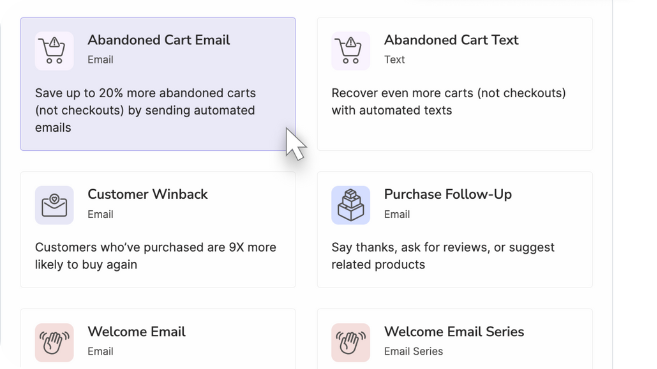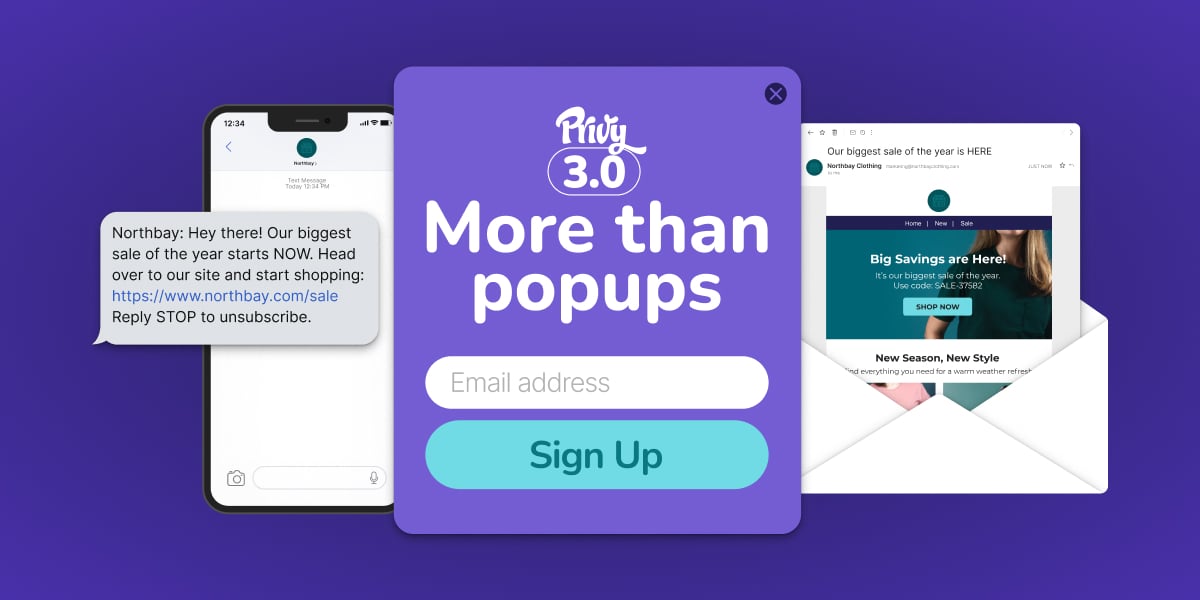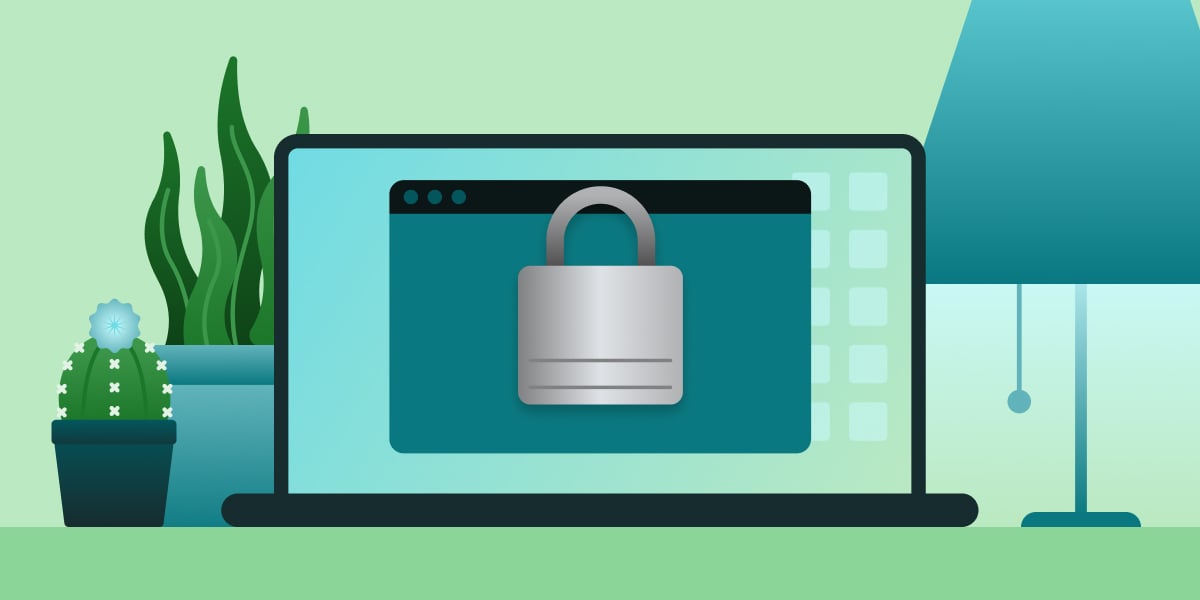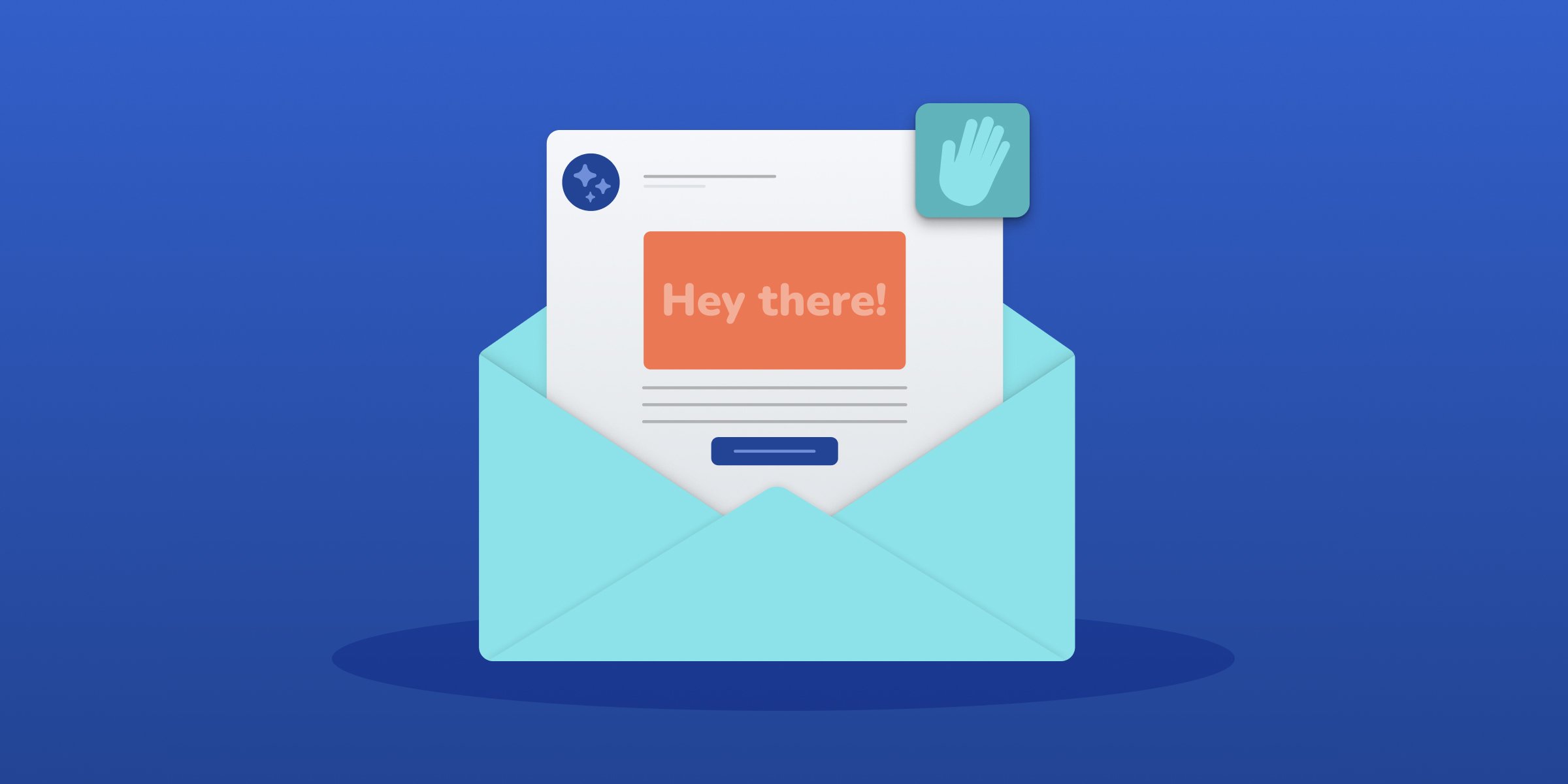100 Marketing Tactics To Grow Your Shopify Store in 2022 (with Examples)
69 min read time
Published on Jan 5, 2022
Written by Lauren Hall
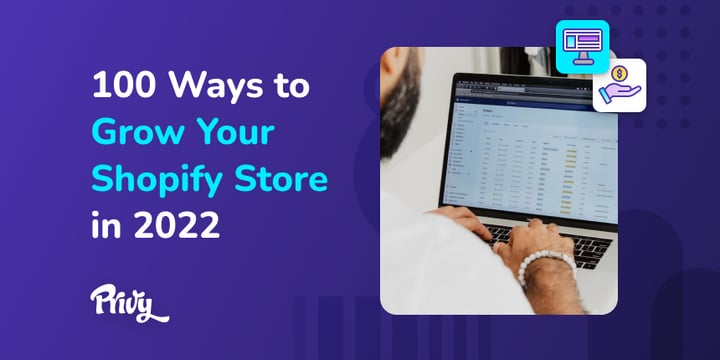
This post was originally published on December 30th, 2020.
It’s official. Ecommerce Marketing School, our daily podcast with tactical tips to help you grow your business, is 2. 🎉
To celebrate, we pulled together 100 tips you can steal in 2022 and beyond.
Whether you’re just starting out or you’ve been running your Shopify store for years, I promise you’re going to learn something from this post.
Focused on converting more of your traffic into customers? Want to get started with SMS marketing? We've got you covered.
But spoiler alert: it's an absolute beast.
So just remember you don't need to digest everything in one sitting. Take a moment to bookmark and keep coming back to this post. Here's a table of contents so you can skip ahead if you'd like:
- Get more traffic to your Shopify store
- Build a brand for your Shopify store
- Improve conversion for your Shopify store
- Steal these email marketing secrets for your Shopify store
- Get started with SMS marketing for your Shopify store
- Save more abandoned carts for your Shopify store
- Boost the average order value on your Shopify store
- Unlock the power of repeat purchases for your Shopify store
Let's dive in.
Get our best content on ecommerce marketing in your inbox 2 times a week
Get more traffic to your Shopify store
Let's face it. The more traffic you can get to your site, the more sales you're going to bring in. Which is why getting more traffic needs to be a constant focus.
If traffic to your store is your biggest blocker for growth, start with these 10 ideas to help you grow traffic at the very top of the funnel.
1. Build ads that convert
When it comes to your ads, it’s important to know that people often don’t know how to interact with the ones that look perfect.
Which is why user-generated content is so powerful. But what happens if you don’t have enough customers to ask for UGC?
Ad expert, Savannah Sanchez, suggests actor-generated content.
Think about it. When you see commercials, they’re actors, not real customers. So why not try the same technique for your own ads?
Ask a friend to help you out and shoot them on an iPhone with very little editing and boom. You’ll have the perfect actor-generated content for killer ad campaigns.
2. Use Facebook Ad Library
If you’re in desperate need of ideas for ads, look no further than the Facebook Ad Library.
It’s an absolute secret weapon because it allows you to see the exact ads your favorite brands (and competitors are running).
So you can get inspiration for your next campaign from any industry imaginable. Because sometimes the best ideas actually come from brands that are totally different than yours.
You don’t want to be doing everything exactly like your competitors.
3. Be patient (and make sure you're collecting emails)
On average, a consumer needs to see your product 7 times before they buy. Which is why it’s so important to try to capture email addresses (especially when you’re running ads).
Just because they landed on your site, definitely does not mean they’re going to buy. So you need to work at building trust and credibility (your welcome series is the perfect place to do this).
That’s why building your email list today is so critical. Because if you wait 'til you really want to bring in sales (ahem, BFCM), chances are visitors won’t be ready to take the plunge. But if you’re engaging with them all year, they know exactly who you are and what your brand is.
4. Send paid traffic to a landing page
If you’re using paid ads to drive traffic to a specific product or set of products, a landing page is the perfect way to handle objections and answer any questions. Make it a seamless experience from start to finish.
The only goal of this page is to get your customer to checkout.
So they should know exactly why they need your product and what’s in it for them by the time they’re at the bottom of the page.
If you’re a paid expert, this is an awesome way to kick things up a notch.
5. Test the influencer waters
Finding influencers is often the hardest part of the process. So #paid’s VP of Marketing, Roger Figueiredo shared his secrets for success when it comes to influencer marketing.
Start with your customer base. If you’re committed to this strategy, it might be worth asking for your customers’ handles somewhere in your flow. Because the best partnerships happen with people who already love your brand since they’re more likely to create more engaging and authentic content.
You just need to consider the fact that influencers are brands in and of themselves. They have their own set of values and beliefs, so make sure your brand aligns with theirs and you have an overlapping audience.
When it comes to reaching out to influencers, be personal. Use one of their posts to create a timely message. And make sure the experience stands out for them.
And for payment, money gets you predictability, whereas gifting your product is better on your budget. Roger’s philosophy is that you should pay the influencers you work with. They’re creators and will make your brand look good. Invest in them and they’ll invest in you.
6. The 3 big traffic buckets
This seems obvious, but not all your traffic is the same. Which means you should be thinking about your site visitors differently. There are really 3 main buckets:
- First-time visitors
- Repeat visitors who haven’t purchased
- Repeat visitors who have purchased
And depending on what your primary focus is, you should be thinking about how you impact the experience for these types of visitors.
If you want to drive more first-time sales, think about what’s going to move the needle for this group. What will get them over the hump? Is it a code for free shipping on their first order? What about a bundle?
Same goes for repeat visitors who haven’t made a purchase. They’re clearly interested in your products, but what would it take to get them to actually buy? You could try creating an FAQ doc to bust common objections.
And lastly, if you’re trying to encourage repeat purchases, maybe you can suggest products based on previous purchases.
The bottom line is, you should always be thinking about the intent for these 3 kinds of traffic and what you can do to improve their experience. Because a better experience = more sales.
7. Start with educational content
When Monica Grohne launched Marea, she knew she wanted to build an education-first brand.
For Marea, that comes in the form of a blog with content that's focused on supporting their customers, not just with product-specific content, but health and wellness content designed specifically for women:
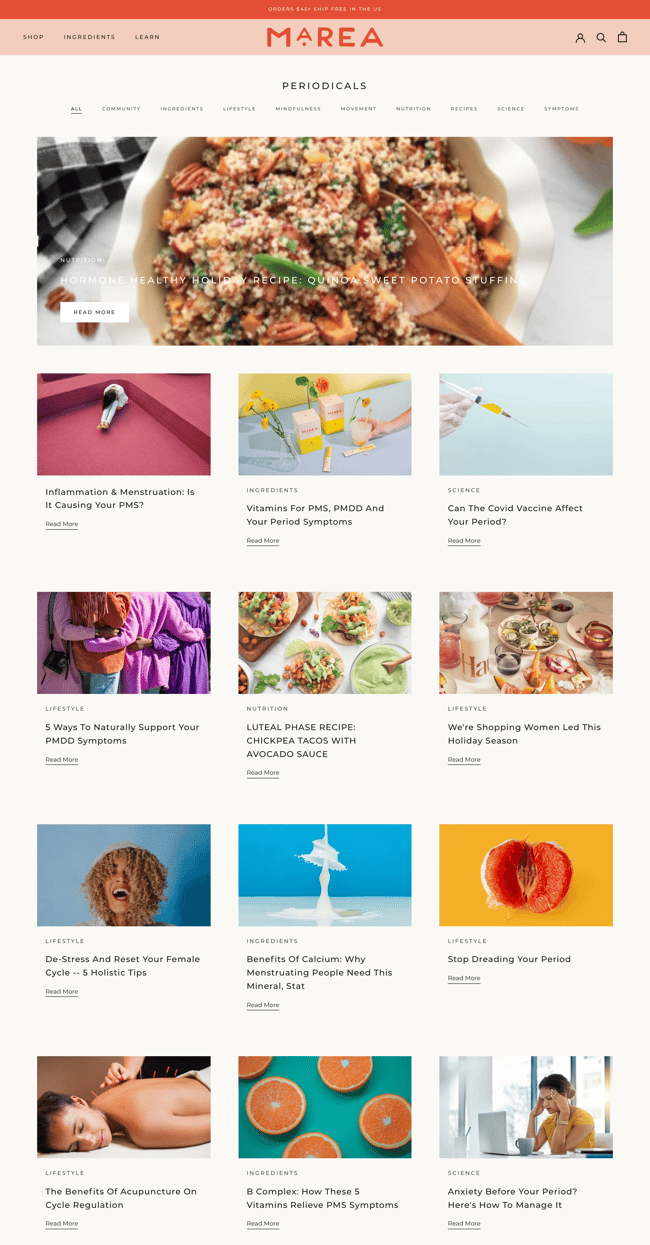 When you focus on value-add content and take the time to cover topics your audience is searching for, you will grow organic traffic to your site. But patience is key.
When you focus on value-add content and take the time to cover topics your audience is searching for, you will grow organic traffic to your site. But patience is key.
Investing in content is a long term investment for your business, so you can't expect results overnight.
8. Find a channel you love
If you do decide to invest in educational content, the first step is finding the right channel for you.
If you hate writing, a blog isn't the right fit. But if you love being in front of the camera, maybe you start a YouTube channel or TikTok.
There are so many different ways to build an audience. But it has to be something you're going to be consistent about. That just won't happen if you constantly dread putting a post together or recording a podcast episode.
So before you commit, think about what the long term vision looks like and how you're going to execute on it every single day. That's the only way you're going to see results.
9. Try out a collab with a like-minded brand
A collaboration is the perfect way to get in front of a like-minded brand’s audience.
Take a look at this example from Poo~Pourri and Super Coffee:
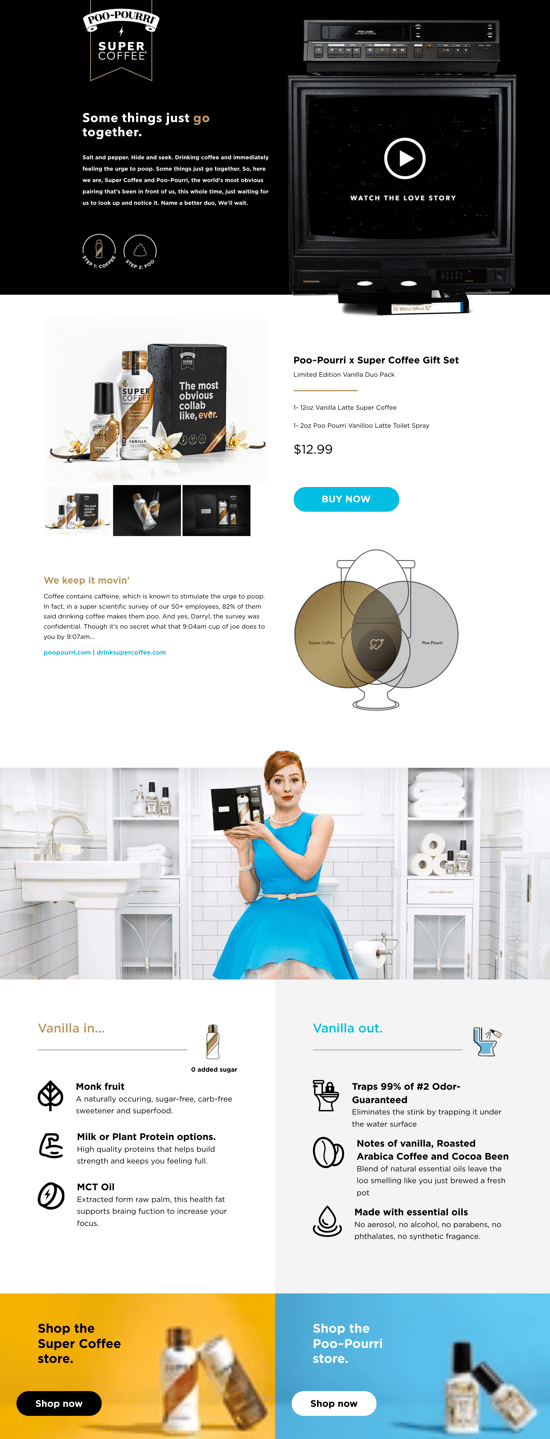
Humor and entertainment goes a long way. And if you can lock in the right partner, this can be super simple. You don’t even have to come up with a brand new product…
In this example, they’re not using new products, it’s a branded bundle of existing products with awesome packaging.
Not only will this boost traffic to your store, but if you do it correctly, you’ll bring in serious sales too.
10. Build a dedicated coupons page
How many times have you done a search for a coupon code before making a purchase?
Chances are, your customers are doing the same. But rather than coupon sites getting the traffic, you can create a landing page (ex: yourstore.com/coupon) specifically to capture that traffic.
You can include any live coupons on this page (just make sure you're keeping it up to date). And even if you don't offer discounts you can run this play. Just explain that you don't offer discounts for XYZ reasons. Because your audience is likely still searching for codes.
This is a quick tactic to help you capture more high intent search traffic for your store.
Build a brand for your Shopify store
It's not enough to build an amazing site. If you don't build a real brand from the get go, you're going to have a hard time driving sales and building relationships.
Luckily, there's a ton you can do to create a brand your audience loves.
11. Have 3 versions of your story
You started your store for a reason, right? And you should be telling that story any and everywhere you can. Because your story will connect your customers and prospects with your brand.
Plus, people want to buy from other people, not a faceless company with no personality. That’s why it’s so important to nail your story from the very beginning.
...but most brands don’t take the time to do it.
To be really successful, you should have 3 versions of your story to use across different channels.
The long brand story
This should be the 1-page, full length version of your story. You can use this on your homepage as a letter from the founder or on your about page. It could also be included in a card that you send out to first-time customers as part of the unboxing experience.
The short brand story
For this one, you should take what you have for the 1-page version and condense it into 1 paragraph. You can use this in everything from your abandoned cart emails to order confirmation emails.
The brand headline
The last version you need to have is the 1-sentence version of your story. It should be front and center on your homepage, in your social bios, and feed your ad creative.
Your story should fuel every piece of marketing you do. It’s going to win you customers and keep them coming back over and over.
And if you’re looking for inspiration, Ben’s favorite hummus brand, Ithaca Hummus, nails every aspect of their story.
12. Build a killer "about us" page
Once you have your story, make sure you're using it. An "About Us" page is the perfect place to showcase why you built your business and get your audience bought in to your mission and vision.
Here's an insane example from Fly by Jing:
 It highlights Jing, the founder, her personal story (including photos!) and the why behind the brand. Not to mention the design is insane.
It highlights Jing, the founder, her personal story (including photos!) and the why behind the brand. Not to mention the design is insane.
Remember that the more you can tie your business to you, a real person, the better your chances are of landing first-time and repeat customers.
13. Focus on your copy
Writing is hard. Even people who are good at it don’t always like doing it. But well-written copy can help you stand out from the crowd (and over customers).
You want to nail your headline. But remember that your tone is everything. Be conversational. If you wouldn’t use a word or phrase when you’re talking to a friend, you shouldn’t use it in emails or anywhere on your site (a 4th grade reading level is perfect, seriously).
And you should avoid big blocks of text. Short, choppy copy is your friend.
14. How to use content to build your following
Content is an investment in organic growth. So it shouldn’t be an afterthought.
But it does take time and consistency. Which is why it’s so important to figure out what you’re good at and like doing. Is it writing? Video? If you're camera shy, you probably don't want to choose video...
From there, come up with a list of topics. Here are 6 content ideas to get you started on the right foot:
- The story: Why’d you start the company?
- Think about important keywords for your brand
- Answer common support questions
- What about common sales objections?
- Instructions/guides for when people get your product
- Scan your reviews to get ideas
I promise that getting started is the hardest part. Once you get in a rhythm, content will be second nature. And by then, your efforts will hopefully be starting to pay off.
15. Get social on Instagram
When it comes to social media, it can be tempting to chase followers. But if you have thousands of followers and no engagement, your number of followers doesn’t matter.
Which is why there’s no magic number when it comes to the number of followers you should have.
Start by figuring out how easy it is to find your brand’s profile in search. Does your profile photo make it immediately recognizable? How do your most recent photos look in the feed? Do you post your content at the right times? Do you have a good mix of videos, images, behind the scenes? Are you leaning into the personal side of your brand? What about UGC? Do you have screenshots of reviews?
Comments are a signal of strength and if your followers are tagging friends, that’s an amazing sign you’re onto something. Just make sure you’re engaging with the comments. Yes, it will turn into a support channel sometimes, but you need to respond to everything.
And try using the search bar to find people talking about your industry, types of products, then comment on their posts. Be fun, add value and bring joy to your audience.
Last thing: don’t sleep on stories. And turn a few of them into highlights.
And remember to mix in asks to follow you on social every now and then across your other channels. Just don’t harp on the number of followers you have. It’s definitely not the secret sauce to finding success on Instagram.
16. Be entertaining
When it comes to entertainment, there’s no better brand to look to than Dude Wipes.
Sean Reilly has shown time and time again that he understands the power of creativity in marketing.
They react quickly when it comes to current events.
They sent Barstool’s David Portnoy a brand new product to open live because they know his audience aligns perfectly with theirs.
They entered a local chili contest and won and their post went viral.
They got millions of eyeballs on their logo during the World Series with a handmade poster that made it on camera.
If you’re scrappy and willing to try different things, you can get an idea off the ground even if you don’t think of yourself as a marketer.
17. Build a community
Bella Dona has more than 350k followers on Instagram. And even with such a large following, they’re focused on building a real community.
They understand exactly who their customers are, which makes it really easy for them to share content that resonates.
And they treat their followers like friends. If you need inspiration for your own Instagram, Bella Dona is a great account to follow. They’re definitely doing it right.
18. Be where your customers are
If you really want to build a community, you need to know your customers inside and out.
If you do, you’ll know exactly where they’re spending their time. Which makes it really easy to figure out where you should be spending your time so you’re not wasting it on channels that don’t matter to your audience.
Take Vivian Kaye. She built an audience and got to $1M in revenue without ads or email. All because she built a community by understanding her customers and remained hyper-focused about building real relationships with them. Whether it meant responding to DMs or having insanely good customer service, she was always there when her customers needed her.
And that’s taken her a long, long way.
19. Build relationships with your audience
Bedrock Bakers founder Steven Friedman tries to reach out to 1-2 customers every single day. It's a proactive way to see how things are going, gauge happiness, and build real relationships.
Think about how powerful it would be if the founder of one of your favorite brands reached out just to check in. Not to sell you anything, but to really stay connected to the people who keep their business running.
This is a super simple thing you can do to build your brand, keep your customers coming back again and again, and stay top of mind.
Start with once a week (or even once a month!) and see what kind of impact it has. You might decide it's worth doing more often.
20. Build hype
Your customers want to feel like they’re getting access to something special. Which is why building hype and launching exclusive products work so well.
So if you’re giving your VIPs early access to new launches or deals, let them know! Explain that you’re opening it up to everyone else in 24 hours to drive urgency.
Offer an exclusive gift with purchase for a specific window.
There are so many things you can do here. So get creative and really lean into hype and exclusivity to drive sales. Brands that do an amazing job building hype have insane followings.
21. Update your unfurl images
When you’re mindlessly scrolling through social media, think about what’s going to stop people and actually get them to click (for your homepage, product page, blog posts, etc.).
That’s where an amazing unfurl image can really shine. It’s what people see when any of your urls are shared. It can be through text, on Slack, on social, really anywhere.
So you should take the time to make your unfurl images great.
And if you’re not sure what people see, take your homepage url and either text it or Slack it to yourself. Just so you have an idea of what this might look like. Here’s an example of a brand that really nailed it:
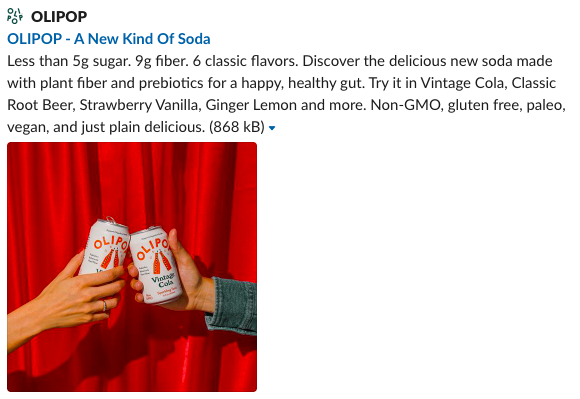
Check to see what some of your favorite brands are doing for their unfurl images.
Just remember this isn’t a one-and-done thing. Go through and check out your product page images and make sure you include them whenever you launch something new.
And they’re really easy to update in Shopify. Go to your admin, click the online store tab, for the theme, click customize, then you’ll find theme settings and a social tab where you can edit/add new images.
Bonus points if you include real people – it makes your brand feel human.
22. Kick your 404 page up a notch
Think of all the times you’ve been browsing on your favorite stores and come across a broken link. Well, those broken links actually take you to what’s called a 404 page.
And you might think, “Why would an error message be a marketing opportunity?”
Well, when you design an amazing 404 page, you can actually use them to get your visitors back on track by pointing them to your most popular collections, FAQs, or blog like Hims does:
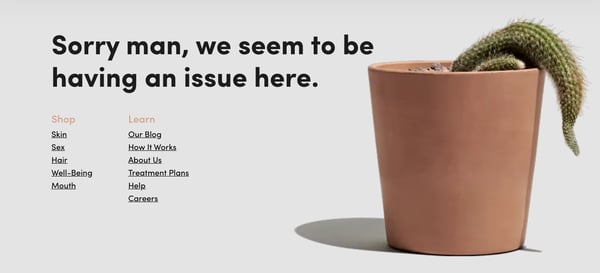
And even some of the biggest ecommerce brands in the biz don’t have great 404 pages. But if you’re looking for inspiration for your own 404 page, look no further.
23. Create an unboxing experience they’ll remember
Your unboxing experience is the only time you’ll get a 100% open rate. Which is why it’s super important to make it count.
But you don’t have to spend a fortune to take your unboxing experience to the next level.
A handwritten note can go a long way. And it doesn’t cost you anything (except time and a card).
Custom packaging is another way to boost your customers’ experience, but that route is a little more expensive.
Just think about the kind of experiences you remember as a consumer and try to replicate those. But seriously. You can never go wrong with a handwritten note.
Improve conversion for your Shopify store
Have the traffic coming in but can't seem to get that traffic to buy? That's where your conversion rate comes in.
And whether you're a $100k business or a $1M business, conversion rate needs to be top of mind. Because even minor improvements can have a serious impact.
Here are some ideas to get you started.
24. Choose your offer (and understand the impact on conversion)
“What’s a good conversion rate?” We get this one a lot. And luckily, billions of site visitors have completed 500M+ forms.
Which has helped us identify consistent benchmarks for 3 different campaign types.
Signup campaign conversion rate
There’s no coupon involved, you’re just asking people to join your list. Something like this:
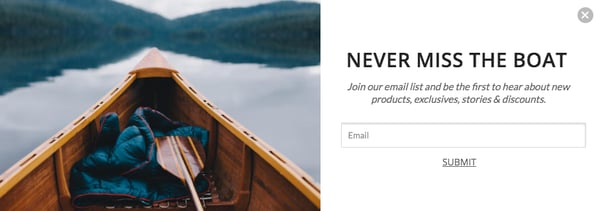
With a signup campaign, you should expect to convert 1% of visitors.
If you’re not into welcome discounts, this might be a good place to start. Just keep in mind that the better the offer, the more signups you’re going to get.
Coupon campaign conversion rate
The offer here could be something like 15% off or free shipping on your first order.
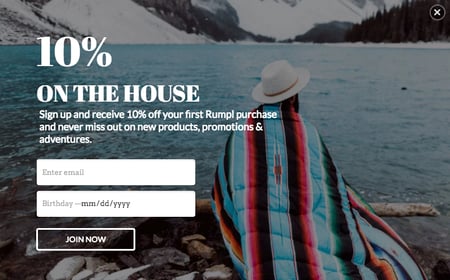
With a coupon campaign, you should expect to convert 5% of visitors.
Enter to win campaign conversion rate
This can be everything from a chance to win free products to a gift card. There are SO many options here. So use it as your opportunity to be creative. And by the way, spin to win campaigns are a perfect way to create an interactive experience.
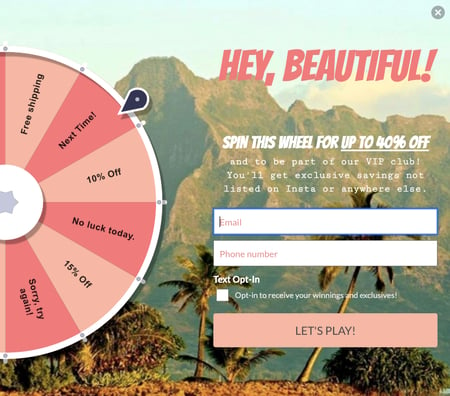
With enter to win campaigns, you should expect to convert 10% of visitors.
So do you need to offer a discount or reward to incentivize signups? No! But as you can see from the increase in conversion (we started off at 1% and worked our way up to 10%) that it definitely has an impact on the number of new subscribers you’re going to get.
Just remember: You can always start with a simple signup campaign and work your way up from there.
25. Choose a display type
Growing your email list needs to be a focus if you want to drive real revenue from your email program.
That’s why it’s so important to understand your options when it comes to building your list. And the fact that your offer is really what’s going to define the success of your campaign (check out the conversion rates above!)
Popups
A popup is the most popular display type for email signups.
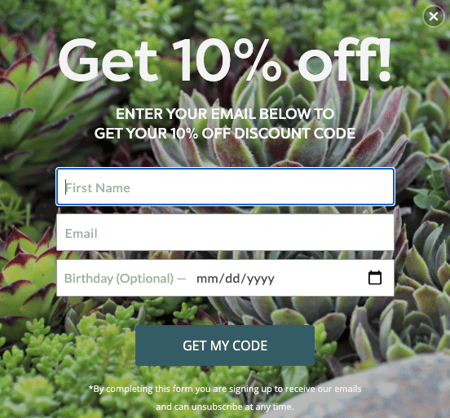
Flyouts
Flyouts are perfect for mobile devices because they appear at the bottom of the screen and are a little more subtle than a popup.
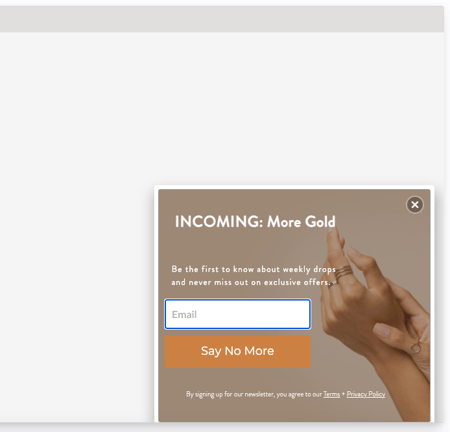
Banners
A banner is a full-width display at the top or bottom of the site that’s typically a little thicker than a bar.
 Bars
Bars
Another full-width display at the top or bottom of your site, a bar is the most subtle display type. And a free shipping bar is the most common use case.
 Spin to win
Spin to win
This campaign type tends to convert really well, but they might not get you the highest quality subscribers so make sure you use them sparingly (and keep reading for the best way to use them!).
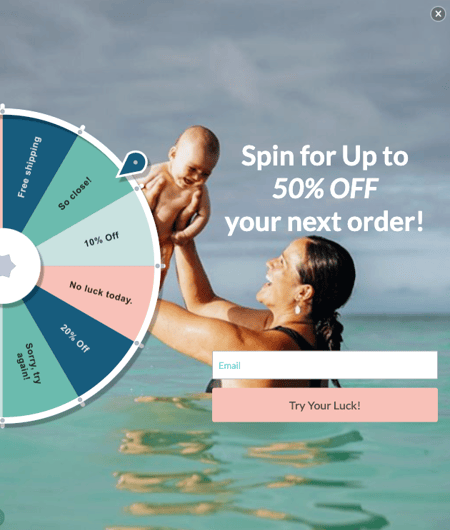
Embedded forms
You’re probably used to seeing these in the footer of many sites. They’re great to include, but shouldn’t be your primary form of collecting email addresses.

There’s absolutely a time and place for each format. But if you’re just getting started, a popup is the way to go. Just make sure it works on mobile (350 pixels wide x 400 pixels tall will do the trick for both desktop and mobile).
And aside from a bar and embedded forms, which are really subtle and don’t convert that well, you really can’t go wrong with any of the options. And by the way, you can use Privy to build each of these display types.
26. Consider the targeting for your popups
Sharing the right message at the right time to the right audience is critical to your success.
When it comes to your welcome popup, for example, you should target first-time visitors and make sure it doesn’t show up too soon.
Start with a 5-second timer or 75% scroll. Which means it’ll show after 5 seconds or if someone scrolls 75% of the way down your page.
27. Launch a welcome popup
You probably already know how important it is to build relationships with your customers. And email is an unbelievably effective way to do that.
When you do it right, you can use email to create a bond with your subscribers and drive them back to your site to (hopefully) make a purchase.
Not to mention the fact that you should strive to get to a point where 30%+ of your revenue comes from email.
So how can popups help you get there?
Well, more emails = more $$.
And the easiest way to turn visitors into subscribers is with a welcome popup. That’s why you’ve probably seen so many popups like this one:
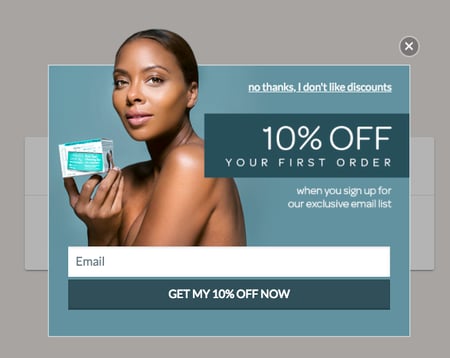
If you don’t already have a welcome popup on your store, my biggest piece of advice would be to set one up ASAP (you can use Privy to set you your welcome popup today).
You don’t have to include a discount, but we definitely suggest including some sort of offer to incentivize a signup. It could be a free gift, free shipping on a first order, or anything else you can dream up, just remember: the better the offer, the more people are going to subscribe.
28. Make your campaigns feel like a native part of your site
Popups can help you convert more first-time visitors, recover more carts, and drive more repeat purchases.
Let’s be honest, though. They kind of get a bad rap…
Historically, they didn’t have great design and the experience was terrible.
When they’re well-designed and show at the right time, they feel like a native part of your site rather than a nuisance. Like this one:

29. Use a tab with your popups
When you’re building out any sort of form (popup, fly out, banner) there are a number of triggers that determine when the popup will load. Think: timers, scroll, exit intent, etc.
And these are all automatic triggers, which means it’s not something your visitors are controlling. But tabs are triggered by your visitors. Here’s what a tab might look like:
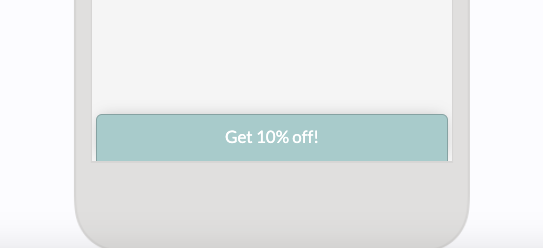
Helpful hint: on mobile, you might want to put your tabs on the right side of the screen because most people are right-handed.
This strategy works really well because your visitors are showing intent. Because of this, tabs are by far the best-converting trigger we see.
Traditionally, if your visitors don’t sign up for your email list right away, there’s no straightforward way to access it again. But tabs allow your visitors to come back to your popup if they weren’t quite ready to give you access to their inbox the first time around.
Find out how tabs helped one brand generate an extra 1k subscribers in just 30 days.
30. Show coupon codes on the screen
If you opt to offer a discount code in any of your campaigns, make sure you have a thank you page that includes the code.
Don't make your new subscribers leave to check their inbox for the code – it might mean they never come back!
You're much more likely to land a sale if you include it on the thank you page.
31. Give unique coupon codes a shot
Ever wonder why some brands use something like ‘WELCOME10’ while others use something crazy like, ‘TB7-8JI-JK89?’
Welcome10 is an example of a master coupon code, while TB7-8JI-JK89 is a unique coupon code.
If you’re using a master code, everyone will see the same code. But master codes are unique for each subscriber.
So why should you be using a unique coupon code?
Outside of the fact that they can’t be shared with coupon aggregators, you can also use them to drive urgency because you can set the code to expire after a certain length of time.
So if you’ve only used a master coupon code til now, try out a unique coupon code.
32. Send a coupon reminder email
You’re probably familiar with this scenario. Someone signed up for your list but didn’t ever follow through and use their coupon code to make a purchase.
Luckily, there’s a feature in Privy that allows you to follow up with these folks.
You can send an email (or series of emails) to the people who signed up for your list but didn’t use their code. And don’t worry – if you have a series of emails and someone makes a purchase, they won’t receive any others in the series.
I know. It sounds too good to be true, right? Well, it really is that simple.
Think about your own life. It’s so easy to get distracted and forget about a list you signed up for. So sometimes a little nudge is all it takes!
33. Create an on-site coupon reminder
An email isn't the only way to remind your subscribers about a coupon code. Audience targeting is your friend when it comes to creating a relevant experience for your visitors.
And you can actually create a reminder for people who have signed up for your email list, but haven’t used their coupon code.
A popup or bar campaign are both perfect ways to do it. And you can include their code right in there.
You can also show it on exit intent as a reminder.
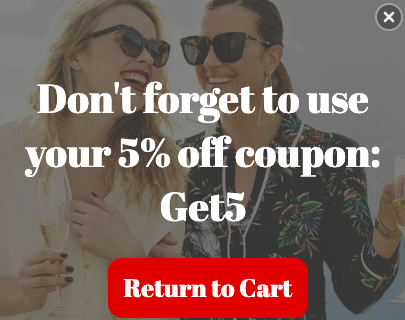
34. Drive sales with targeted popups
Once you’re comfortable with popups (and have a welcome popup and cart saver), there are tons of ways to use targeted popups.
Here are a few ideas from our customers:
Outer Aisle used a popup to build hype for an upcoming launch.
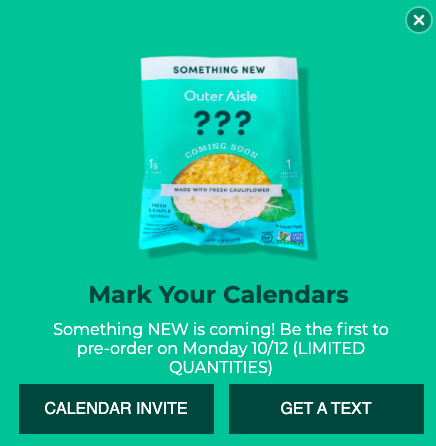
This campaign had a 20% conversion rate and led to their biggest sales day ever.
35. Gamify pop ups with spin to win campaigns
Love them or hate them, spin to win campaigns can be incredibly effective if you’re intentional about when they’re used.
And if you’re not sure what they are, they’re basically a gamified form that adds a lottery-type element to your campaigns.
And these 2 brands do an amazing job with spin to win.
Death Wish Coffee targets their spin to win campaign to a certain audience, which means not all new visitors see it.
But they’ve been able to turn thousands of visitors into subscribers.
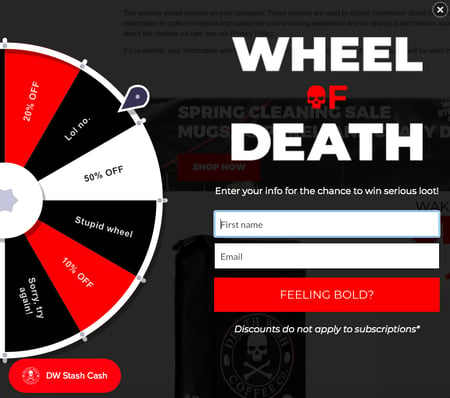
By the way, it has a 25% conversion rate. That’s insane...
So if you’re on the fence about it, you can always test it out with a small segment (ex: certain paid audiences, specific pages, etc.) and let the results speak for themselves.
Don’t knock spin to win til you try it. They can convert like crazy and feel like a native part of your site if take the time to do it right.
36. Invest in amazing product photos
In the ecommerce world, your visitors are judging a book by the cover – because it’s all they have to work with at the very beginning.
Which means that brands that invest in great photos have a total leg up. You can definitely take photos on your iPhone, but if you’re looking for some outside help, Soona is hands down the way to go.
They take professional photos and videos while you tune in from the couch. All you have to do is send them your products and any notes about the types of shots you need, and they do the rest!
Your photos fuel everything. So they’re definitely worth the time (even if it’s not your own!) and investment.
37. Test out GIFs
Everyone loves a good GIF. Whether they’re in emails or social, they always catch your eye. That’s because the motion stands out and make viewers want to click.
Whether you sell drinks, or handbags or clothing, there’s no question that there’s a way for you to test out a GIF.
They’re engaging and will definitely get attention (and hopefully improve your conversion). And you can easily use Canva to create one. I promise you don’t need to be an expert.
But if that’s really not your thing, Soona has you covered.
38. Use a free shipping bar to improve conversion rate
You’ll see your conversion rate in your Shopify analytics dashboard. But it’s helpful to know that the average conversion rate for a Shopify store is somewhere between 2-3%.
Which is why improving conversion is such a big deal for ecommerce brands. And because shipping cost is such a big reason for abandonment, a dynamic free shipping bar can work wonders when it comes to conversion. Here’s an example:
 But then when you add anything to your cart, a dynamic bar (like you can create with Privy) automatically updates to reflect the amount you need to spend to qualify for free shipping.
But then when you add anything to your cart, a dynamic bar (like you can create with Privy) automatically updates to reflect the amount you need to spend to qualify for free shipping.

And ecommerce experts have seen big results from free shipping messages.
When Sean McGinnis, Head of Marketing at Kuru Footwear, launched a static free shipping bar that said, “Free Shipping. Free Exchanges. Free Returns.” they saw a 23% increase in the overall store conversion.
The Good’s Jon MacDonald has found that free shipping messaging is the only thing that has moved the needle on conversion rate.
Kelly Vaughn from The Taproom recommends a free shipping bar to all her merchants. Because the right threshold can get visitors over the hump and boost AOV.
And Kurt Elster, Host of The Unofficial Shopify Podcast, has found that the lower the threshold, the higher the conversion rate (with free shipping on all orders out-performing the rest by far).
So if you haven’t tested out a free shipping bar, it can be an amazing lever to boost your conversion rate and average order value.
39. Think outside the box with your free shipping bar messaging
Yes, the primary use case is to show your free shipping threshold and encourage visitors to meet that.
But you can get pretty creative with your messaging, too. Try out these unconventional ways to use your free shipping bar:
- Launches: If you’re launching a crowdfunding campaign, new product, podcast, or anything new, you can use your bar to announce it.
- Back in stock notifications: If a product is back in stock, it’s a great way to run a promo without running a discount.
- Milestones: Use it as a way to celebrate wins! If you hit 500 reviews, broke a milestone number of orders shipped or anything else worth noting, call it out.
- Create scarcity and drive urgency: If you know you’re going to be running out of a specific product (you have less than 50 units available, for example) or have a shipping cutoff date shoppers should know about (these are big around the holidays), a bar is a great way to share the message.
- Manage customer support expectations: If you’re experiencing shipping delays, this is the perfect place to call it out.
- Out of office: If you’re going to be off the grid for any amount of time and you don’t have someone covering for you, let your customers know! If you had a baby or are getting married, share that! People want to celebrate with you.
40. Focus on amazing support
Amazing support can scale for your brand. But it starts with you, the founder.
And it means being responsive, turning haters into advocates, wowing customers, and building trust.
Early on, it’ll teach you exactly what your customers are thinking about. If you keep getting the same questions over and over, create a guide or add it to your FAQs! If you’re getting the same feedback on products, you’ll know what to do differently next time.
So while it can be really time consuming, it will help you immensely.
And if you need inspiration, 2 of Ben’s favorite books for building an awesome support engine are Hug Your Haters and Delivering Happiness.
41. Collect reviews for your store
Social proof is critical for your business. Because your customers don’t have the opportunity to walk down an aisle, touch your products, and make a decision.
So outside of making the product look amazing with photos and great copy, reviews are the best way to boost your brand and build trust with potential customers.
Just keep in mind that when and how you ask for reviews is unique for your brand, but there are some tactics that work well pretty much across the board when it comes to getting reviews.
Stuart, the founder of Junip, lives and breathes reviews for ecommerce stores, and he shed some light on best practices.
Your review request should really come from you, the founder. You want it to resonate on a personal level, so you should include messaging like, “Thank you so much for the support. It means the world that you bought from us…”
You want to hit them with an email as close to unboxing as possible (except for products that take a lot of time to appreciate). So make sure you take the time to understand what makes the most sense for your business. An A/B can be hugely beneficial here.
You should aim to be in the 10% range in terms of responses. And if you’re getting less than 5% of people to respond, you need to rethink your strategy.
42. Build a dedicated reviews page
Your reviews have to live on your product page, but a dedicated reviews page can also help on the SEO side (ex: yoururl.com/reviews). The social proof on your product page will help drive more conversions. But you want to be careful not to just include the 5-star reviews. Detailed feedback is what gets people to make the purchase.
The beauty of reviews is that you can repurpose them across all your marketing channels. Use them in emails, on social, in ads, the sky’s the limit when it comes to how and where you use reviews.
Here's a great reviews page example from Jot coffee:
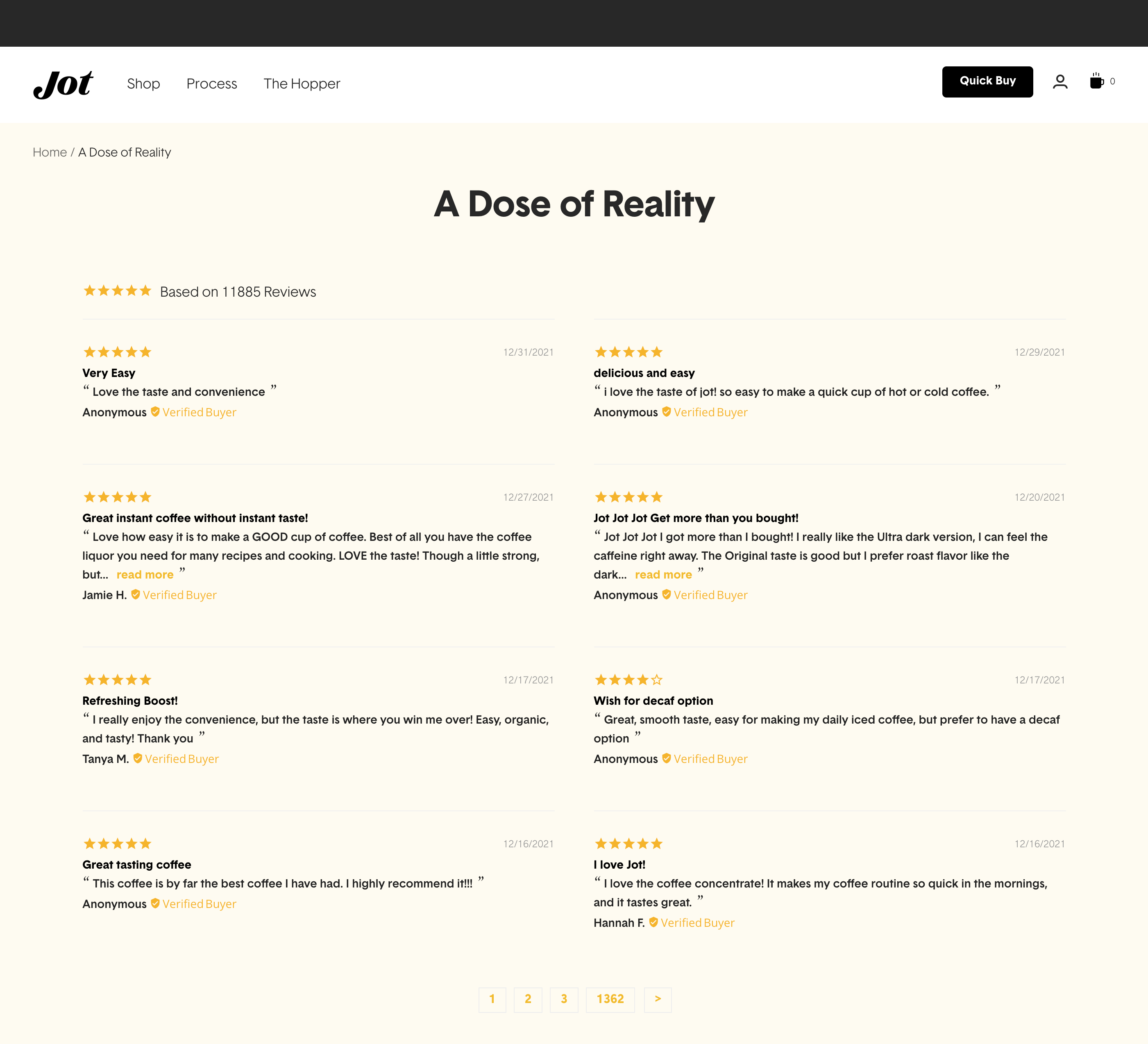
43. Build an FAQ page
It might not be immediately obvious right away what questions your customers are going to have about your products.
That’s why it’s so important to document the most common questions you get and build out an FAQ page.
It’s not always going to save you from getting repeat questions, but it will definitely save you (and your customers) a ton of time.
There’s a reason so many ecommerce brands have an FAQ page.
And if you’re feeling stuck, take a peek at some brands you love and find out what questions they answer on their pages. Then you can make it your own from there!
44. Make returns seamless
One of the worst parts about shopping online is having to return orders that didn't work out. Which means first-time buyers are especially conscious of your returns policy.
In fact, 67% of shoppers check the return policy before making a purchase. Pro tip: if the percentage of shoppers looking at your return policy is that high, make sure it's easily accessible. You don't want them to drop off just because they weren't able to find your returns page.
Here's a great example of a returns page that answers the most important questions in a single paragraph:
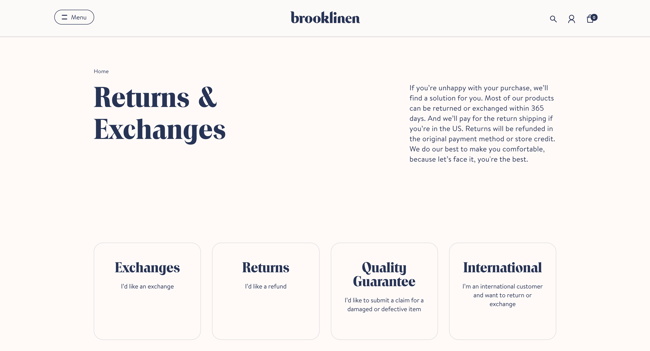
Loop Returns' Alex McEachern knows that returns often have a negative association for a brand (you're losing money, right?), but he thinks about a killer return policy and experience as one of your strongest marketing assets.
And if you give shoppers confidence with your return policy, you’re going to increase conversion for your store.
45. Build a waitlist for new products
If you’re thinking about launching a new product, there’s something really intriguing about waitlists.
People are literally raising their hands to tell you they’re interested in your product. How amazing is that?
But depending on how long you expect the wait to be, you need to make sure you’re building momentum and hype along the way.
You can’t just ask people to sign up and expect them to purchase the second it’s available.
Share behind the scenes and sneak peaks. Get them so excited about what’s coming that they can’t help but buy the second it’s available.
46. Send low stock alerts
Scarcity is an incredibly powerful marketing tool to have in your arsenal. Think about all the times you’ve seen something like “3 left in stock” and it made you think, “OMG I need to buy right now!”
So whenever your inventory is running low, let your subscribers know!
Not only will it bring in sales for your store, but it will give you a reason to send back in stock messages that will only encourage more purchases.
No matter what you’re selling, low stock alerts should be part of your playbook.
47. Send back in stock notifications
Don’t stop at low stock messages! Take it a step further with back in stock notifications once your inventory is back. Even to the people who weren’t on the waitlist.
Back in stock implies a product was insanely popular, which might be enough to bring in even more sales.
AYR does an amazing job with this in their subject lines. Here are 6 examples:
- 22,000-person-waitlist
- The Sellout Jeans
- BACK IN STOCK
- RE-STOCKED
- Sold out twice | It's baaaaack
- This sold out in 6 days
When your products sell out, you can use that in all your future marketing. Keep that in mind whenever you let your subscribers and followers know a best-seller is back.
48. Create a product quiz
Your #1 goal when you get a new visitor to your store should be to make the experience as seamless as possible.
And confusion is the best way to lose a sale. Luckily, a quiz that points your traffic in the right direction about which product(s) might work best in everyday life can be the perfect way to convert more of that traffic into sales.
Plus, you're capturing emails along the way. So even if you don't land the sale immediately, you have more than one shot to make it happen.
Kabo, a dog food brand, also uses their quiz as an opportunity to capture information (like your dog's name, breed, age, weight, etc.) to give you a more personalized experience down the road.
 This allows them to send relevant content, product recommendations, and build trust over time, increasing the odds of converting this traffic into customers.
This allows them to send relevant content, product recommendations, and build trust over time, increasing the odds of converting this traffic into customers.
49. Lean into shipping deadlines
Shipping deadlines aren’t just a great way to drive urgency during BFCM. You can use these deadlines to bring in sales year round.
Let’s say you sell bathing suits and you have a brand new print that came out just in time for the 4th of July.
You want to make sure anyone who makes a purchase knows when the deadline is to receive their order in time to celebrate.
There are so many use cases you can use shipping deadlines for no matter what time of year it is.
And these deadlines are the perfect excuse to post on social, send emails, texts and so much more.
50. Build your entire calendar for the year now
I know. It sounds daunting. But it doesn't have to be. The fastest way to plan your entire campaign calendar is to figure out which holidays you want to capitalize on this year.
Everything from Valentine's Day campaigns to birthday plays celebrating your brand's anniversary can be a great excuse to come up with a campaign and send emails and texts to your subscribers to bring in sales.
Start by looking at your biggest sales days last year and figure out where you need to fill the gaps most. Had a super slow March? Think of a campaign now that will help you boost numbers.
Constantly scrambling to come up with ideas isn't a great way to set yourself up for success this year. Start now and get way ahead of the game. Then you'll know exactly what needs to be done when.
51. Install a heatmap
A heatmap can work wonders for improving the conversion rate of your Shopify store.
In fact, Rebecca Worsley, the Founder and CEO of Rainy City, recommends it to every single brand she works with (and she’s worked with more than 300!).
Her go-to platform? Lucky Orange. It’s only $10 a month and it tracks all of your pages and has the power to give you invaluable insights about performance.
If you’re not seeing improvements to conversion rate once you make changes, it’s time to get back in there and run another test.
The truth is, most brands aren’t using heatmaps. Which means you have a great chance of getting a leg up on the competition if you give them a chance.
52. Test out buy now pay later
The easier and faster you make it for customers to buy, the more likely they are to convert. Fun fact: the Shop Pay checkout experience is 4x faster than typical checkouts.
And with buy now pay later options like Affirm, Afterpay and Klarna, you can improve conversion even further. Especially if you have higher ticket items.
This payment flexibility could be exactly what your audience is looking for.
Think about optionality at checkout as the exact opposite of getting to a register in person and finding out they only accept cash.
So if you’ve never tested buy now pay later as part of your checkout flow, now is the time. It’s low lift and can have a huge impact.
53. Focus on sustainability
Turns out over ⅔ of shoppers will pay a premium to have more sustainable options.
Which means there's a huge opportunity for you to lean into more environmentally friendly practices when it comes to everything from your packaging to products.
Think about what Shopify does with Shop Pay. For every purchase, they help offset the carbon footprint by planting trees. As a consumer, it makes you feel good (and it's way faster than typing in all your information every time you check out).
Even if you're already focused on sustainability, are you making it clear to your audience what goes on behind the scenes? Highlight your practices any and everywhere you can.
Something as small as new packaging could be a great opportunity to send a note to your audience to call out the fact that you're making a switch in an effort to be a more sustainable business. It goes a long way.
54. Experiment with QR codes
QR codes can be super effective if you use them in the right context because they give quick, easy access to any URL you want to highlight without having to type anything in.
Plus, they came back with a vengeance with the pandemic, which means most people know how to use them.
Not sure exactly where you might be able to use a QR code for your store?
There are so many use cases.
You could incorporate it into the unboxing experience and point customers to leave a review.
Or bring shoppers directly to the checkout experience to remove friction.
Maybe you’re running a print ad and you want to send viewers directly to a product page.
Get creative here. They couldn’t be easier to create. Shopify has a free tool, or you can right click in Chrome and you’ll see an option to generate a QR code. There’s no reason not to give a QR code a try this year.
55. Remember you're never really done
The Good’s Jon MacDonald eats, sleeps and breathes conversion rate optimization. And for him, it’s a practice, not a checklist. There’s no quick fix or secret sauce. And you’re never really done.
Because your customers need change over time, so you’re never truly optimized, but always optimizing.
The best place to start is with the customer experience. And if you wouldn’t do something in a retail store, you shouldn’t be doing it on your website. Things like false timers don’t build trust, they do the exact opposite.
And if you’re only paying attention to your competitors, it’s a dangerous game. Because you don’t really know if what they’re doing is working – there’s a reason race horses wear blinders.
Steal these email marketing secrets for your Shopify store
Email is the lifeblood of a healthy ecommerce store. It’s an audience YOU own. Not Facebook. Not Google. You.
Email might not be the shiniest way to unlock growth for your busienss, but it’s the gift that keeps on giving. And we’ve found that every email you collect is worth $15.
With the right focus, email should drive between 30-40% of your total revenue. Imagine a single channel bringing in that much revenue for your store.
Pair a solid email marketing strategy with a continuous list growth and you'll be well on your way to bringing in serious sales for your store.
56. Start with email automation
When you’re first getting started with email, it’s easy to focus on broadcast emails (new product announcements, sales, etc.) rather than automated emails. But your automated emails literally make you money while you sleep and the ROI only grows over time.
I promise getting your automated emails up and running is one of the most powerful things you can do for your business. So where do you start? These are the 3 automated emails you need.
- After signup email
- Abandoned cart email series
- Purchase follow up series
Keep reading to learn more about each of these emails.
And remember that this is the foundation. Once these are up and running, you can keep building up from there.
57. Grab attention with your welcome email
Welcome emails have crazy high open rates and can generate 3x more revenue than your average emails.
Plus, it's your only chance to make a great first impression.
Yes, you have to deliver on whatever promise you made to get them to join your list (discount code, code for free shipping, etc.). But it's also an awesome place to reinforce your story and set expectations from the very beginning.
I'm obsessed with the welcome email from Muddy Bites:
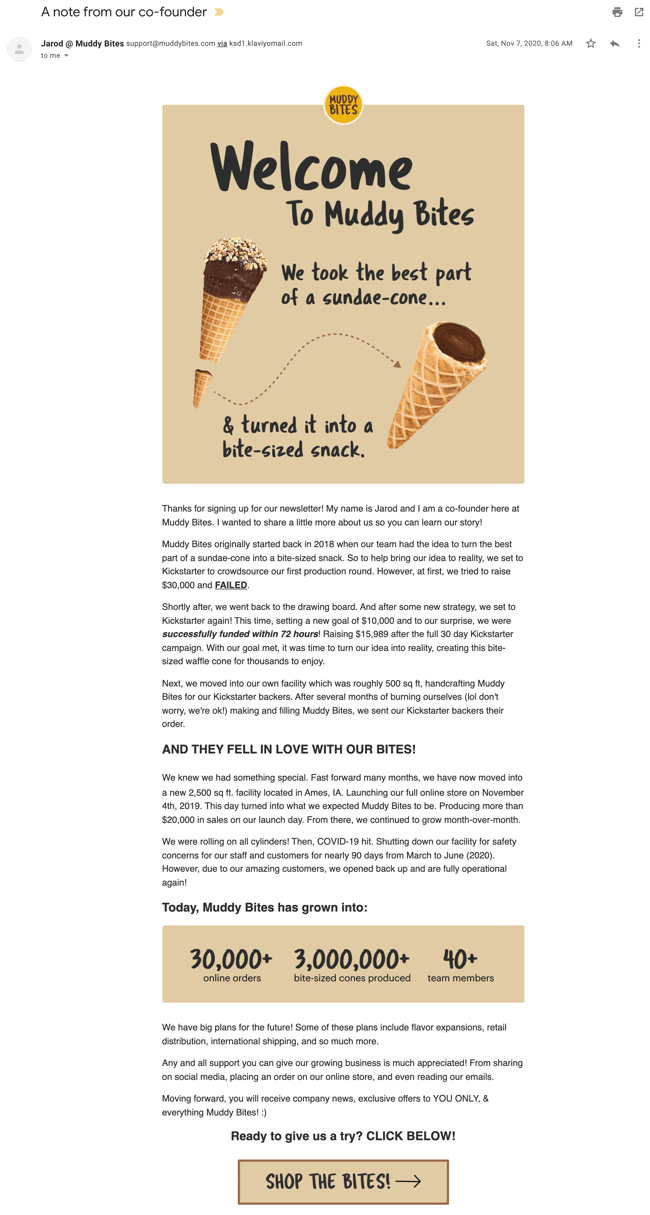 It's from a real person, they're positioned as underdogs, it tells a story, shares examples of growth and points you back to the store to buy.
It's from a real person, they're positioned as underdogs, it tells a story, shares examples of growth and points you back to the store to buy.
58. Focus on list growth all year
Your reach is the number of subscribers you have.
When it comes to your email list, you need to constantly be growing your audience. And your welcome offer is going to have a big impact on that growth.
Remember that more emails on your list = more revenue for your store.
59. Establish your brand with frequent email sends
How often are you reaching out to your subscribers? Remember that more often than not, it takes more than 1 interaction for people to feel comfortable making a purchase. So you should get in a regular cadence with your emails. You want your subscribers to be excited to hear from you.
60. Build customer habits with consistent email sends
You don’t want to send 0 emails 1 month and 6 another. That’s why consistency matters. Because when your subscribers expect to hear from you, they’re more likely to engage with your emails. And you want to make sure the messages you’re sending have consistent information. If you’re always sharing different information, it’s going to confuse people.
61. Get creative and stand out
The content you share in your emails is obviously incredibly important. So make sure you ask yourself if your emails would make you want to click and go to the site. If you’re not excited about what you’re sharing, there’s no way your subscribers will be.
A great test is to look at the promotional emails you've opened in your own inbox. Figure out why and try to replicate that for your brand.
62. Write winning subject lines for your emails
When it comes to email, the goal of the subject line and preview text is to get your subscribers to open. And there are a few things that go into that:
- Sender name (Hint: You should really lean into the personal aspect here. Rather than just using your brand name as the sender, use something like [Your Name] from [Company Name])
- Subject line
- Preview text
For starters, the average email open rate is 20%. Which is an awesome place to start. But you really need to understand your own email metrics to be able to pinpoint what works really well and what doesn’t.
And your open rate is the most important metric when it comes to understanding your subject line performance. So resist the urge to throw it together at the very end before you click ‘Send.’
Because your subject line is your hook. So if you’re getting a high open rate, you did a great job getting your subscribers interested in whatever it is you wanted to share with them.
Just make sure it’s not too long. Especially because so many people are likely viewing your email on mobile, so you don’t have a ton of space to work with.
Lean into urgency whenever it makes sense. Use deadlines to inspire action.
And casual text like numbers and emojis will likely boost your email performance and help you stand out in a crowded inbox.
The same goes with questions! And timely content.
If email is already a strong revenue-generator for you, better open rates (and subject lines!) will help you make more $ for your business.
63. Keep segmentation simple
Grouping subscribers into segments is something many brands never do because it feels so daunting. But it doesn’t need to be.
If you’re in the $0 – $1M/year in revenue range, you really only need 2 groups.
People who have purchased. And people who haven’t.
It’s that simple. Seriously.
So if segmentation feels overwhelming, start here. It’ll make your messages so much more relevant to both groups and feel much more personal.
64. Send a special offer to people who haven't purchased
I'm guessing you have a bunch of subscribers on your email list who haven't made a purchase.
A simple email targeting this audience with a relevant message is an awesome opportunity for your store.
Take your longtime subscribers who haven't placed an order and craft an offer specifically for them. Call out the fact that they've never placed an order to make your messaging relevant to them and come up with something that's likely to get them to buy.
Then, a couple days later, you can follow up with a last chance reminder email. Just make sure you're excluding anyone who went on to purchase after your first email.
And pssst. This exact playbook brought in $3k in sales for one food brand.
65. Always be improving
It’s one thing to understand the power of email, but another to actually go and execute on a real strategy.
Especially when you always have a million things to do.
But I promise there are ways you can improve your email strategy. If you only have one welcome email, make it a series.
If you don’t have an abandoned cart email in place, set that up. Then make it a series.
There is always something you can do to make your emails better. And when you finally feel like they’re in a good place, take a look again. You might find something you don’t love anymore...that happens to me all the time.
66. Maintain a clean email list
If you maintain a clean email list, your chances of deliverability are much higher. And there are 3 main things you can do to maintain a healthy list:
Have the right permissions in place
We’ve all received those emails we didn’t sign up for.
It’s helpful to remember that just because a customer placed an order, doesn’t necessarily mean that they want to get your marketing emails.
Uncheck the automatic opt in box in Shopify - let them decide if they want your emails.
Make sure your list is up to date
If you started your email list years ago and haven’t done anything to clean it up, it’s probably time to start.
Chances are, you have some emails on your list that aren’t active anymore. So you’ll want to do some serious cleaning.
Check the types of addresses you have
If you have email addresses like @marketplace.amazon.com or sales@, you’ll want to get rid of them. They’re transactional addresses and distribution lists that will hurt deliverability.
Your goal should be to start with a clean list every time you send an email. So if you haven’t spent time keeping your email list clean, you need to make it part of your regular routine starting today.
Start with SMS marketing for your Shopify store
This is THE year for SMS. Attentive found that brands using their platform are bringing in 20% of revenue with text.
Imagine having a brand new channel that could bring in 20% of sales. That’s insanely powerful. And this is your year to get started with text messaging. Here’s how.
67. Grow a healthy SMS list
Before you get ahead of yourself, just remember that your SMS list is likely going to be smaller than your email list. But engagement will be through the roof.
And a successful SMS program starts with list growth. There are so many ways you can grow your list, but if you’re just getting started, think about these three methods:
Growing your SMS list on your site
By far the easiest way to grow your SMS list is to add a phone field to your welcome popup. So rather than just capturing emails, you’re adding phone numbers, too.
You can take that a step further by adding a tab to your site that says something like, “Join our SMS list for 15% off” just for the traffic coming to your store with a previous order.
Or you could add SMS capture to your checkout process. Just keep in mind how many fewer people will be seeing it there.
Growing your SMS list with social
Social is the perfect place to highlight your SMS list and the incentive you offer to new subscribers.
For example, you could have a story dedicated to SMS list growth that points viewers to a landing page specifically designed to capture phone numbers. You can keep it super simple.
Then, you can repeat this weekly or monthly to keep those subscribers coming in.
Growing your SMS list with your unboxing
A QR code on your packaging (or on an insert inside your packaging!) is the perfect way to get customers to join your SMS list. Just make sure you’re making it worthwhile for them!
When it comes to SMS list growth start simple. And remember that even just a couple new subscribers every day will have a huge impact over time.
68. Set up automated texts first
Once you have a solid SMS list, what’s the next step? Like email, automation is the perfect way to ease in (and drive results).
Send a welcome text
When a new subscriber joins your list, you have to send an after signup or welcome text. This is the perfect place to set the stage for the rest of your relationship.
No matter what you say, keep it consistent with your brand voice.
Here’s an example of copy you could use in your welcome text:
It’s official. You’re now a VIP. Thx for joining. You’ll get early access to sales and be the first to know of new product launches. Shop now [link].
Send an abandoned cart text
Remember that engagement is way higher with texts. So add an abandoned cart message to your repertoire to bolster the abandoned cart messages you’re already sending.
You don’t necessarily need a coupon, either. A reminder might be enough to turn browsers into buyers.
Just be extra mindful of regulations when it comes to SMS. You can only send a single cart abandonment text, for example. But if you use the right platform (like Privy), these controls will already be built in so you don’t have to spend a single second worrying about it.
Once you have your welcome and abandoned cart messages up and running, post purchase and on fulfillment messages are a great next step to continue building out your SMS program.
69. Start sending broadcast texts
Once your automated texts are running smoothly, it’s time to start sending broadcast messages to your subscribers.
Remember: you want to treat your text subscribers differently from your email list. Give them a reason to be on your list consistently. A discount code to join is a great place to start, but that can’t be the only time you’re adding value:
Here are 4 broadcast text ideas you can steal right now to drive sales and make your SMS subscribers feel like VIPs:
- A behind-the-scenes update from you, the Founders
- Early access to new products
- Special offers just for SMS subscribers
- Helpful content (guide, no other CTA)
And if you’re looking for SMS inspiration, here’s an insane resource with tons of examples.
Just try not to overthink your one-off broadcast messages. Part of the beauty of SMS is the fact that you don’t have to spend a ton of time on design and the faster you can get to the point, the better.
70. Use SMS and email together for the biggest impact
It's true. SMS and email definitely have strengths of their own (SMS is better for short, time-sensitive messages, while email is great for longer form content). But that doesn't mean you should only be using one.
The best, most effective way to use both channels is to use them together. So lean into both channels and figure out what works best for your business.
Here's a great example of using email and SMS together effectively from bond eye:
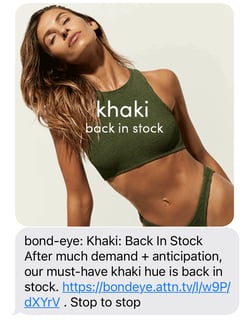
.png?width=550&name=screencapture-mail-google-mail-u-0-2022-01-10-16_29_24-edit%20(1).png) This is exactly the kind of one-two punch you can deliver when you use email and SMS together thoughtfully without tons of extra effort. The same message and images delivered across multiple channels.
This is exactly the kind of one-two punch you can deliver when you use email and SMS together thoughtfully without tons of extra effort. The same message and images delivered across multiple channels.
Save more abandoned carts for your Shopify store
It's no secret that 70% of carts are abandoned. I know. It's insane. But if you're not doing anything to encourage this high intent audience to come back, you're leaving money on the table every single day.
Here are abandoned cart plays you can run to bring visitors back to your store and drive serious sales.
71. Launch a cart saver popup
Cart abandonment is something every brand has to deal with. But a cart saver can help you reduce the number of abandoned carts you see dramatically.
We’ve consistently seen that cart savers can help you reduce cart abandonment by 10%.
If you target visitors who haven’t made a purchase yet, you can use a cart saver to give a little extra incentive to complete their purchase.
If you’re going the discount route, you should plan to have it be a little higher than your welcome popup to seal the deal. But you can also offer free shipping, a free gift with purchase, etc.
Cart savers don’t need to be overly complex to drive $$.
72. Get a little more advanced with your cart savers
If you’ve already seen the magic of cart savers in action and you want to take it to the next level, this is for you.
With advanced cart savers, you segment your visitors based on things like the amount of $ or specific product they have in their cart. You can also segment based on location, which means you can have different offers for international traffic.
Here’s an example of an amazing advanced cart saver campaign. This brand keeps their designs dead simple:
But they target different audiences with different offers, using the formula, “Purchase now and receive X.” And the code is only valid for 1 hour to drive urgency.
They use cart value and location:
- For domestic traffic between $20-30, they offer a code for free shipping
- For domestic traffic between $30-50, they offer 20% off
- And for international traffic, they offer $5 off
This strategy has helped them recover 200+ orders. Seriously this will help you turn 30 minutes into constant revenue for your brand.
73. Capture emails with your cart savers
So you’re familiar with cart savers now. But what if you don’t want to offer a discount?
Well, you’re in luck. Because you don’t need to have a discount in order to grow your email list.
You can do something as simple as this:
Just keep in mind that your conversion will be higher with a discount code.
74. Understand the difference between cart abandonment and checkout abandonment
You probably already know that there’s a huge dropoff between the number of people who add something to the cart and number of people who actually complete the purchase.
But what you might not know, is that there’s a difference between cart abandonment and checkout abandonment.
Checkout abandonment means people are getting far enough in the checkout process that they’ve entered their email.
But a much larger percentage of shoppers never make it to that stage.
That’s why you want to make sure you’re sending abandoned cart emails. Which means you can reach out to people who’ve added items to their cart and for whatever reason, decided to bounce.
And because we know about 70% of carts are abandoned, you're missing out on a huge opportunity if you’re only sending checkout abandonment emails.
Not to mention the fact that pairing a welcome popup with cart abandonment emails helps you identify and recover 5x more than traditional checkout abandonment emails.
75. Calculate your abandoned cart revenue opportunity
Now that you know the difference between cart and checkout abandonment, it’s time to find out how to calculate your revenue opportunity just from abandoned carts.
And you can do all this with Shopify analytics.
In your dashboard, you should see a section for your store’s conversion rate. It’ll look something like this:
You’ll see exactly how many people added something to their cart, reached checkout, and ended up converting. (And by the way, if you’re only sending checkout abandonment emails, you’d only be reaching about half of the people in this example – 278 out of 539.)
For some quick math, take total sessions with an order and divide by total sessions where something was added to the cart. In this case, 207/539 = 38% cart completion rate.
Then take the total sessions where someone added to cart and subtract total sessions with an order. 539 – 207= 332. Which means 332 orders were abandoned.
Now, if we take that number and multiply by your AOV, you’ll get the revenue opportunity just from abandoned carts.
Which, in this example means, 332 x $84.41 = $28,024.12.
So if you only focus on improving that number, you have the power to have a significant impact on your abandoned cart revenue.
Most brands just focus on a single abandoned cart email. But if you add in a cart saver and 3-email abandoned cart series, you’ll see a big lift in your revenue (more on both in this post).
76. Send these 3 emails to recover abandoned carts
Now if you’re not sending abandoned cart emails, here’s what you need to do.
Send 3 emails.
Email #1 should go out 1 hour after the cart is abandoned (you want it to be timely!). And it’s 100% support driven. No coupon, just a note from you, the founder, checking in and letting them know you’re there to answer any questions or point them in the right direction.
Then, 24 hours after the cart was abandoned, the 2nd email should go out. This is when you can introduce something like a discount code to incentivize the purchase. Just make sure it includes an expiration (we recommend 24 hours to drive urgency).
The last email should be sent 48 hours after abandonment. And it’s really just a reminder to use the discount code that’s expiring.
This super simple series can help you save an insane amount of sales.
Just ask Suzy Cohen. This exact series helped her save 20% of abandoned carts, which translated into more than $100k in revenue. WILD.
77. Get real feedback
If you send a 3-part abandoned cart email series and it didn't result in a sale, it's the perfect opportunity to ask for real feedback.
Send a plain text email from you, the founder, asking why they haven't purchased.
It's the absolute best way to get honest feedback about why your visitors aren't buying from you so you can improve the experience over time and convert more abandoned carts into sales.
It will also help with overall conversion! Because chances are if something is holding back one customer, the same thing is true for many others.
78. Try switching up your abandoned cart subject lines
I know, it sounds simple. And that’s because it is. But if your abandoned cart emails aren’t getting the results you’d like to see (or you just want to run a simple test), it might be as easy as changing your subject lines.
That’s what one of our CS wizards, Lisa Shea did for one brand she works with…
And they saw insane improvements.
They had a 3-email series, and the subject line was the same for each email: “Complete your purchase.”
The 1st email has a 10% discount code, the 2nd a 15% code, and the 3rd a 20% code.
This series was running for 9 months and generated $41k in that timeframe. Pretty amazing, right?
But when they changed the subject lines for the 3 emails to:
SL #1: Here’s your 10% off
SL #2: 15% off, just for you
SL #3: 20% off your cart. Last chance
They recovered $29k...in just 30 days. That number was up from ($4500/month on average). That’s almost a 6x increase! So if you want to get more out of your abandoned cart emails, try this simple test.
79. Promote other places to buy your product in your abandoned cart emails
This one’s from ecommerce expert, Lucas Walker. If you sell your products anywhere other than your Shopify store, your abandoned cart email series is the perfect place to share that.
Why? Because price isn’t always the reason people don’t buy. Maybe they want to purchase from a familiar place (like Amazon) or pair it with an order they’re already placing.
So if your products are available anywhere else, like Amazon, Etsy, retail locations or popups, let your shoppers know!
It might be exactly what they were looking for and will encourage them to make the purchase. Then, down the road, hopefully they buy directly from you.
80. Send an abandoned cart text
Once you have your abandoned cart emails in place, it's time to add an abandoned cart text to your playbook.
While you can't send more than one abandoned cart text message to your subscribers, you can use it to complement to your emails and convert more abandoned carts into sales for your store.
Here's a 5-step playbook you can steal:
Step 1: Identify the carts you want to target
Because you're limited to 1 abandoned cart text message, you have to be strategic about who's receiving your messages.
That starts with identifying which abandoned carts can bring the most value for your business. Maybe you want to trigger a send only for your high value carts. Or maybe you just want people who left a certain product behind to get your message.
Step 2: Sweeten the deal
Once you know which carts you're going to target with your abandoned cart texts, think about whether or not you want to send more than just a reminder that they left something behind.
You could include a coupon code that expires after a certain amount of time to drive urgency or offer free shipping.
And while you absolutely can send just a reminder message without an incentive, just keep in mind that conversion will be higher with an offer.
Step 3: Craft your message
Now it's time to come up with your messaging. Don't overthink it. With SMS, you want to keep your messages as simple and to the point as possible.
The formula is really simple:
- Include a reminder they left something behind
- Add in an incentive to boost conversion
- Make sure there's a link back to their cart
And that's all you need!
Step 4: Time your message
You want to make sure you're sending your text while your product is still top of mind. Typically 1-2 hours after abandonment is a good range to start with.
Just keep in mind you cant send an abandoned cart text more than 48 hours after abandonment. So the sooner it goes out, the better.
Step 5: Activate your abandoned cart text
Now it's time to turn on your abandoned cart text and start saving more sales automatically. Once you have enough data, you can review performance and make tweaks to improve your results.
If you're not already sending abandoned cart texts, now is the time to get started.
81. Try a handwritten note
Seriously. How many times have you received a handwritten note from a brand? What about a handwritten note focused on an order you left behind?
This isn't something many brands are doing, which means it can be a huge opportunity for you to stand out.
Ryan Light, the CEO of 7-figure brand, Pistol Lake started doing this for high value abandoned carts. Here, he usually includes a discount code.
But he also sends one to VIPs. Typically, this one doesn't include a discount code, but he might follow up with an email that does.
Just think about where this might fit in with the rest of your abandoned cart strategy. You want to make sure it's a seamless experience for the consumer. If you're sending emails, texts, and a handwritten note, it might be a little much. But it's a great opportunity to experiment and find out what works well for your store.
Boost the average order value on your Shopify store
Increasing your average order value is one of the best ways to boost revenue for your business.
Which is why getting your current customers to buy more should be top of mind all year round. Here are tactics you can use to improve your AOV and overall revenue.
82. Set your free shipping threshold
Let’s face it: no one loves to pay for shipping. And the #1 question we’re getting about free shipping is, “how should you choose a free shipping threshold for your store?”
Well, we like to keep things as simple as possible. So while there are definitely more complex calculations you can run, we like to set it 15% higher than your average order value.
When customers see that they are close to getting free shipping, they are incentivized to purchase that extra item to qualify for your sweet free shipping deal.
First, go into your Shopify dashboard and pull your AOV over the last 12 months. Then multiply by 1.15 and use that as your free shipping threshold to start.
If you see a boost in your AOV, you might want to try bumping it up a bit. But if it doesn’t move the needle, try 10% instead. Just don’t overcomplicate it.
83. Understand the difference between cross-selling and upselling
McDonald's is the age old example. They’re famous for asking “Do you want fries with that?” and “Do you want to supersize that?”
And when you think about it, it’s pretty simple to tell which is which.
The fries aren’t a replacement, they’re in addition to the main meal you’re already getting, likely a burger. They’re a complementary product, which means this is a classic cross-sell example.
The supersize option, though, is a replacement. You’re getting the bigger version, right? That’s an upsell.
And you can easily apply both of these tactics for your brand. They’re incredibly powerful because you’re squeezing more out of the traffic you already have.
Here’s a great example of a cross-sell (and by the way, you can use Privy to power your cross-sells):
84. Leverage your free shipping bar
For Lucas Walker, free shipping is the single greatest upsell mechanism that he’s used for his store (outside of bundling).
For his brand, it wasn’t profitable for customers to buy 1 product, so they really had to push bundles. And a free shipping threshold had a significant impact in supporting that initiative.
So he recommends taking your AOV and adding $10 to it as a starting point for your free shipping threshold (Ben’s formula is slightly different, so test out both and see what works best for your brand!).
And engineer your pricing specifically for the products you want people to buy. So if you really don’t want someone to order just one item, make them a way better offer to incentivize a different behavior.
A great way to do that is to promote free shipping just under your best-selling bundle. Which means purchasing that bundle would mean they get free shipping.
85. Use targeted popups
A beauty brand increases AOV by asking shoppers if they want to double the size of a specific product in their cart. And it has a 25% conversion rate.
A wine brand has a featured reds of the week popup that visitors only see if they scroll halfway down the red wine page (showing real intent and interest).
There are add-to-cart buttons for each product that make it a seamless experience. Even better, it has a 10% add-to-cart rate.
So once you have the basics down, get creative with your popups. Just make sure they enhance the experience rather than detracting from it.
86. Encourage purchases with free gift bundles
Let’s face it. Everyone loves free stuff.
So why not use that to your advantage and leverage a free gift to incentivize more purchases and get shoppers over the hump if they’re thinking about ditching?
The opportunities are endless here. You can use smaller items you already sell or create special, limited edition products just to use as free gifts. Here’s an example to inspire you:
The more creative the offer is, the more attention it’s going to get. But you can always start small and get more involved as you go.
87. Give merch a shot
No matter what you sell, chances are you’re trying to increase your AOV. Turns out killer merch is an awesome way to do just that. Especially if you already have an incredible base of loyal customers.
Take a look at this example from Curie:
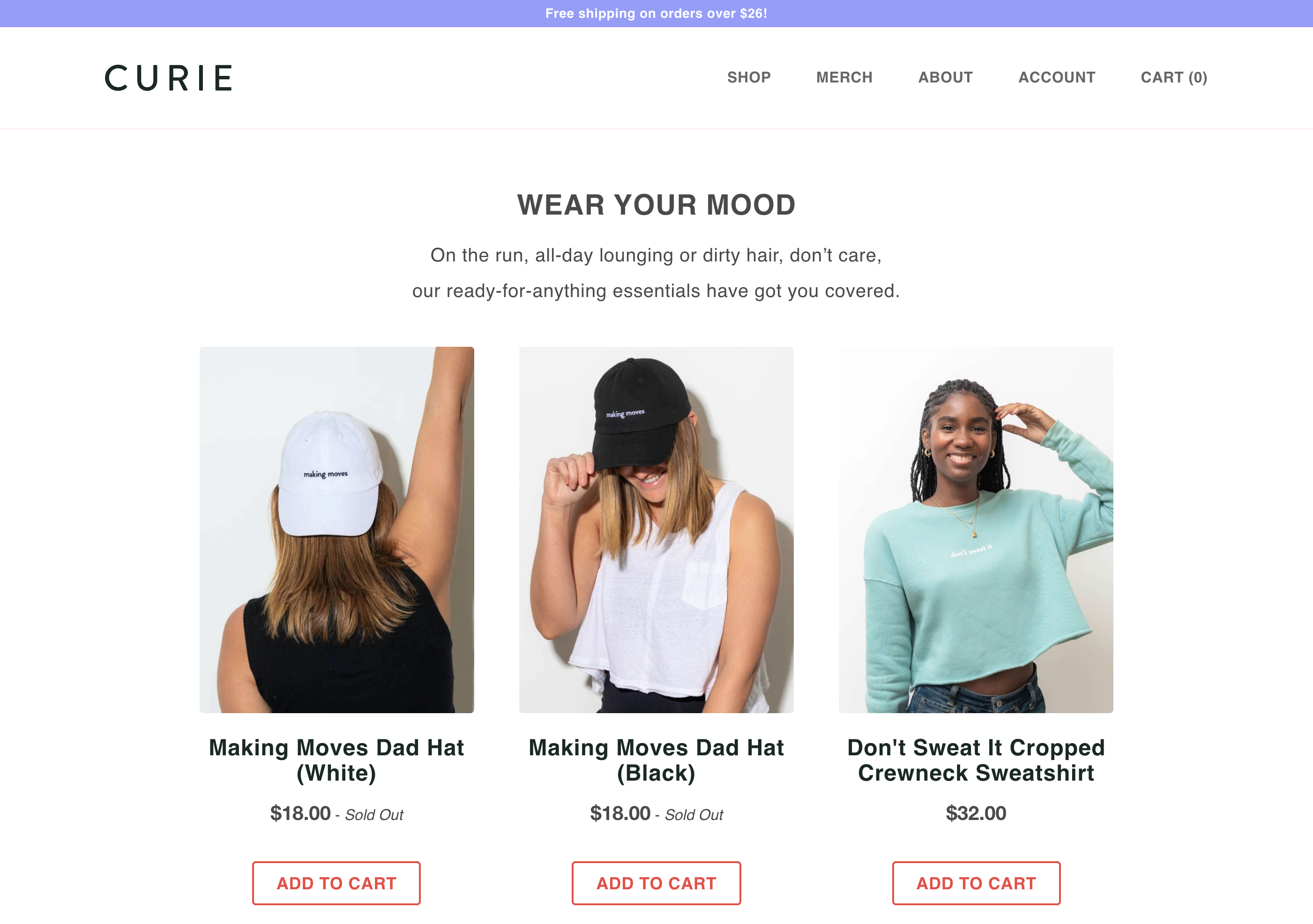
They sell clean deodorant and personal care products, so a sweatshirt that says “Don’t sweat it” makes perfect sense for their brand.
Plus, their hats are currently sold out in both colors.
If you’re thinking about testing out merch for your store, Printful shared some ideas to get you started:
- Hoodies
- Sportswear
- Premium t-shirts
- Eco-friendly products
- Hats
- Wall art
- Phone cases
- Drinkware
- Bags
Unlock the power of repeat purchases for your Shopify store
There are a couple ways to grow your business: you could spend all your efforts generating awareness and acquiring first-time customers, or you could spend some time acquiring new customers and focus on turning those buyers into repeat customers.
Don’t get me wrong: acquiring new customers is hard – you write content, pay for ads, and still, only a small percentage of visitors will ever buy.
So when you unlock repeat customers, that’s where the magic really happens. But it can feel like a total afterthought.
So this data will help you understand why repeat customers are so important: repeat customers are 9x more likely to buy and have an AOV that’s 3x higher than first-time buyers.
80% of a store’s future profits come from buyers they’ve already sold to. So if you’re not focused on building awareness AND driving repeat customers, you’re missing out on a critical opportunity.
88. Incentivize another purchase
So now that you understand the value of repeat purchases, you can use this email type to hopefully lock them in.
After you’ve landed a sale, you can email your customer with a discount code to use on their next order.
Just make sure you include an expiration date. It’s a great way to drive urgency and encourage another purchase.
The messaging can be really simple. Let them know you want to thank them for their purchase, so you’re sharing a discount code to show your appreciation.
And it’s a great place to reinforce your story and the fact that you’re a small brand.
89. Send an order confirmation email that stands out
You can still send this from Shopify to make sure it includes the full order summary your customers are expecting right after they’ve placed their order. But rather than keeping the generic messaging, make it specific to your store.
The standard messaging says something like, “Hi [first name], we're getting your order ready to be shipped. We will notify you when it has been sent.” But why not take it a step further and say something like, “Hey [first name]! You just did a great thing. By shopping with [business name], you supported a small, woman-owned business. And we make everything by hand. Which means you’ll get a one-of-a-kind piece you’ll treasure for a lifetime. We’ll let you know when your order’s on the way!”
It doesn’t need to be anything crazy, but just adding in a couple sentences that are specific to your brand can make a huge difference.
90. Build anticipation after a purchase
This email should go out 24 hours after an order has been placed. It's the perfect time to get your customers extra excited about the fact that they made the decision to buy from you.
You can include information like:
- FAQs
- Your founding story
- How you source fabrics, etc.
Again, this doesn’t need to be anything over the top. It’s just something to keep them excited about their order so that when it lands on their doorstep, they can’t wait to open it and keep coming back for more.
Not only will this keep your brand top of mind throughout the entire buying experience, but it will leave them wanting more.
91. Let your customers know you care
Once your customers have received an order, reach out and ask them about the experience! Get feedback, answer questions and encourage a real conversation.
Not only will this be an insanely memorable experience, but your customers will associate a real person with your business and want to keep buying from your store.
This is something that might not work forever, but when you’re still small, it shows that you really care about your customers. So try it out! If it gets too time consuming to respond to every email you get, that’s a good problem to have!
92. Reward VIPs with new product samples
Imagine if one of your favorite brands sent you a gift out of the blue. It would make your day, wouldn’t it?
Well, that’s exactly what skincare company, Journ, did earlier this year. They were testing out a new product and wanted their VIPs to get a sample before anyone else.
So they sent Ben a small package with a handwritten note, small insert with the description and ingredients, and the product itself.
This is a textbook play to make your most valuable customers feel special. Think about how you might be able to apply this to your brand. What can you send VIPs to thank them for their support and make them feel truly valued by your business?
93. Offer new versions of your product
NUGGS is always improving their product. And they came up with an amazing way to encourage repeat purchases (even if you didn’t necessarily love the last version of the product).
They explain, “NUGGS are constantly being improved by our team of food scientists and engineers in NYC. NUGGS operates like a software company. We take user feedback as we develop new versions of the product, and we keep our users updated.”
So whether you have a single or multi-product brand, you can steal this play any time you make a change or improvement to your products. Tell your subscribers what you’re doing differently and why! Who knows, maybe that’s the reason they didn’t buy the first time. Or they’ll be so excited they’ll buy from you again.
94. Test out a direct mail campaign
Jeremy Roberts is the co-owner and CMO of Tradlands, a women's clothing brand.
They have email and SMS programs, write content, run paid ads, leverage influencers and social media…
But they also use automated postcards to generate about 6% of their revenue every month.
They use Postpilot to offer a discount to first-time buyers to try to incentivize them to come back and buy again.
And they measure success by keeping track of the number of discount codes that are used (this is key – otherwise it’s tough to measure the success of your campaign).
Another direct mail trick they use is a small postcard that looks like a handwritten piece of personal stationary. It goes out to everyone who purchased twice – because their data showed that after that 3rd order, customers stick around for the long haul.
The options are endless if you’re open to testing out direct mail for your brand.
95. Test a targeted spin to win
Zutano also does a great job with spin to win. But their strategy is completely different than the average brand.
They never target new customers with spin to win campaigns. Instead, they use them to drive repeat purchases with customers.
They send a newsletter to their most loyal customers and have driven 1000+ repeat purchases with this strategy.
96. Encourage a subscription (if you have one)
By 2023, 75% of all DTC brands will be offering some type of membership or subscription. That is staggering. And it’s a stat that Bold Commerce co-founder, Jay Myers shared on one episode.
Subscriptions have grown 100% YoY since 2011. And subscription companies get sold for 8-10x their non-subscription counterparts.
And while that probably isn’t your primary objective, if you’re not offering a subscription, you should think about how you might be able to make it work.
Start by asking yourself, “Does this make sense for my brand?”
And if you’re thinking to yourself, “I sell sunglasses, it won’t work,” you’re probably not getting creative enough.
Because at the end of the day, what your customers really value is your taste. So can you create a membership or community to build a recurring revenue stream around?
When you think about your customers as members, it transforms the way you think about them. They automatically become more valuable. Think about it: a membership is a relationship, but a customer is a transaction.
KONG Box and Kencko do a great job with their subscription models. So check them out and start thinking about ways to get recurring revenue ASAP.
97. Try a complete-the-look email
This is why knowing your customers’ purchase history is so important.
Let’s say you sell leather goods and you have customers who have only purchased a wallet, but not a larger item, like a handbag or backpack...
That’s when you can send emails to that segment of customers and encourage them to check out other items that go well with what they already have.
98. Add a gift card option to your store
The ability to purchase gift cards isn’t just a great way to bring in sales during the holidays. It can help you bring in sales all year long.
Think about it. Maybe one of your most loyal customers wants to buy one of your products as a gift, but they’re unsure about exactly what the recipient would like. A gift card is the perfect option.
Here’s a great example of a gift card page:
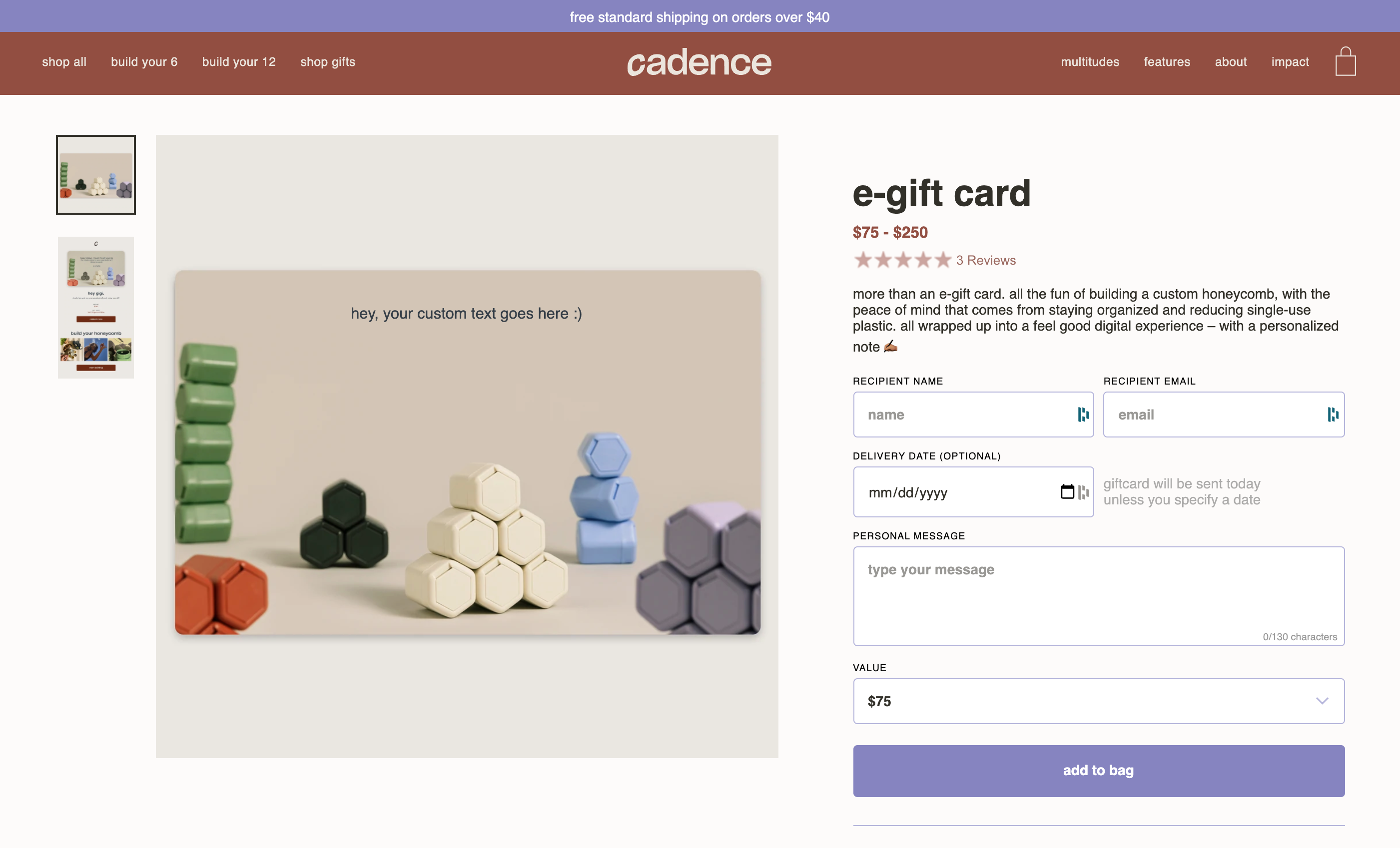 And you can highlight it all year. Whether it’s for Mother’s Day or Memorial Day. Gift cards will be the gift that keeps on giving for your store.
And you can highlight it all year. Whether it’s for Mother’s Day or Memorial Day. Gift cards will be the gift that keeps on giving for your store.
99. Revamp your packaging
It might sound simple, but updating your packaging can actually work wonders for bringing in repeat purchases.
Jason Wong ran this exact play for Doe Lashes just a year and a half in after getting the inspiration from Mercedes. He created a unique batch of an existing product and the only thing that had changed was the packaging.
Then, he leaned into scarcity by producing a limited number of this special edition packaging.
It’s worth noting that this play will only work if you already have a dedicated following. Without that, updated packaging is unlikely to move the needle.
But holiday-specific packaging could be just what your audience is looking for. So if you’re on the fence about this, give it a shot for a specific holiday. If it works well, you can lean into it all year long.
100. Make your loyal customers feel special
Have you ever received an email from a brand you love that made you feel special because it was so specific to your experience with the brand?
This is especially important with your most loyal customers.
Something as simple as an email like this from Muddy Bites could be all it takes to encourage your customers to keep coming back:
 Acknowledging how much you appreciate your repeat purchasers is one of the best tactics for keeping them happy and coming back for more.
Acknowledging how much you appreciate your repeat purchasers is one of the best tactics for keeping them happy and coming back for more.
These are the little things you can do to give them an unforgettable experience they want to share.
Don't be afraid to try new growth tactics this year
2022 is your year. Whether you're going to try 5 of these tactics or 55, there is so much you can do to have your biggest year ever.
Start by narrowing in on your 1-2 major goals for the year and commit to testing a certain number of things for each.
Whether you're focused on boosting AOV, bringing back repeat customers, or building a stronger brand, I promise these ideas will give you a great jumping off point for the entire year.
And remember that you can't do everything. As one person, it's so easy to get overwhelmed. Stay focused and go crush this year.
Subscribe for Updates
Get our best content on ecommerce marketing in your inbox 2 times a week.

Written by Lauren Hall
Lauren is a Brand Marketing Associate at Privy. She's the brains behind all things content. When she's offline, she's obsessing over her Bernedoodle pup, Monster, and plotting ways to being a full-time Vermonter ASAP.
Subscribe for Updates
Get our best content on ecommerce marketing in your inbox 2 times a week.

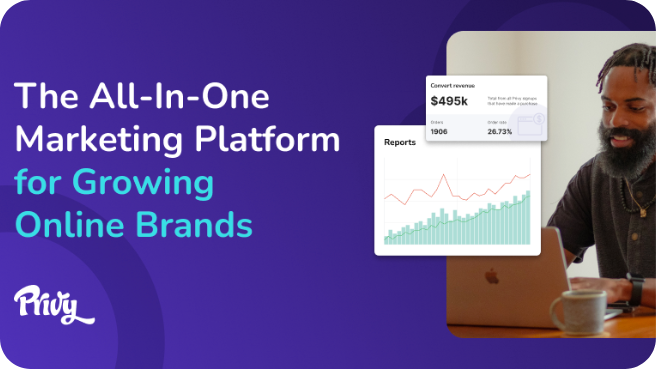
.jpg)
